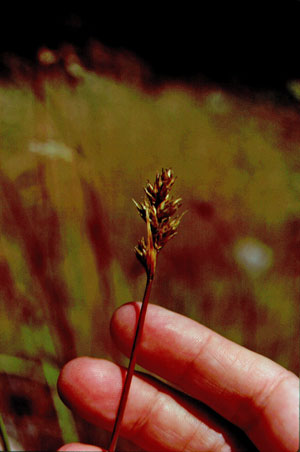DACF Home → Bureaus & Programs → Maine Natural Areas Program → Communities, Plants, and Animals → Rare Plants → Carex adusta

Carex adusta Boott
Swarthy Sedge
- State Rank: S2
- Global Rank: G5
- State Status: Endangered
Habitat: Dry, open places. [Rocky coastal (non-forested, upland)]
Range: Newfoundland south to New Brunswick, Maine and northern New York, west to Michigan, Minnesota, and British Columbia.
Aids to Identification: Identification of species of the genus Carex is usually difficult and dependent upon rather technical characters. Carex adusta is in the section Ovales and it is distinguished by the following characteristics: densely tufted growth; lower leaves are merely scales; 4-15 spikes are crowded into a cluster 2-3 cm long; perigynia are 4.2-5.2 mm long and half as wide, with fine dorsal nerves; floral scales as long as the peryginia; upper portion of the leaf sheath is smooth, lacking minute papillae.
Ecological characteristics: Known to occur in Maine on sandy roadsides and disturbed, dry clearings. This is a pioneer species of open areas that have been recently disturbed by fire or mechanical means, so that mineral soil is exposed. In Maine, it seems to be most common in the coastal region.
Phenology: Fruits July - September.
Family: Cyperaceae
Synonyms: None noted.
Known Distribution in Maine: This rare plant has been documented from a total of 14 town(s) in the following county(ies): Aroostook, Franklin, Hancock, Knox, Penobscot, Washington.
Reason(s) for rarity: At southern limit of range; habitat may be ephemeral.
Conservation considerations: Some populations appear to persist for only a few years. All occur in locations where natural or artificial disturbance maintains open conditions.